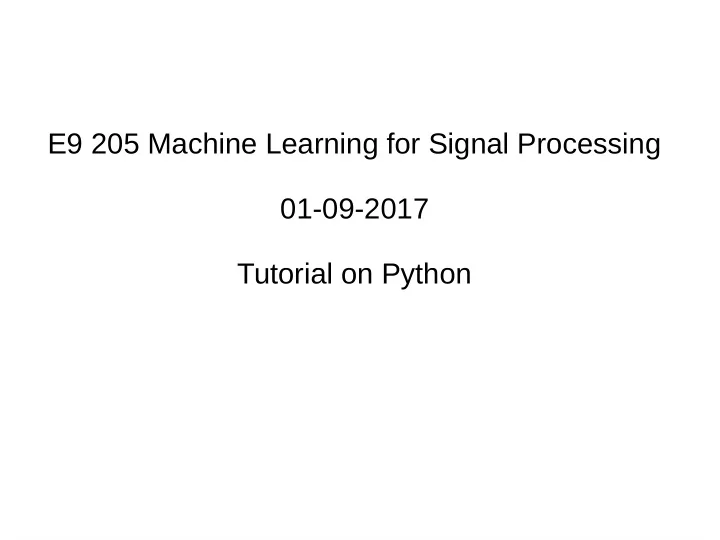

E9 205 Machine Learning for Signal Processing 01-09-2017 Tutorial on Python
Outline ● Basics and control statements ● Functions and lists ● Tuples, Dictionaries, Strings, File i/o ● Modules ● Packages: Numpy, (Scipy, Matplotlib) Reference: [1] Stanford university, Course: “Introduction to Scientific Python” Link: https://web.stanford.edu/~schmit/cme193/resources.html [2] : PythonLearn : http://www.pythonlearn.com/
How to install Python? ● Anaconda – https://store.continuum.io/cshop/anaconda/ ● Very easy to install and also comes with a lot of packages.
How to use Python ● There are two ways to use Python: – command-line mode: talk directly to the interpreter – scripting-mode: write code in a file (called script) and run code by typing in the terminal python Tutorial1.py Tutorial1.py----> print "MLSP 2017"
Comments in Python Anything after a # is ignored by Python ● Why comment? ● – Describe what is going to happen in a sequence of code – Turn off a line of code - perhaps temporarily – Easy to evaluate your assignments..
Control statements ● Control statements allow you to do more complicated tasks. – if – for – while
Indentation In Python, blocks of code are defined using indentation . ● Maintain indent to indicate the scope of the block ● – This means that everything indented after an if statement is only executed if the statement is True. Reduce indent back to the level of the if statement to indicate the end ● of the block – If the statement is False, the program skips all indented code and resumes at the first line of unindented code
Control statements
Functions and lists
Functions Much like a mathematical function, they take some input and then do ● something to find the result. Start a function definition with the keyword def ● Then comes the function name, with arguments in braces, and then a ● colon--> indentend(body of function) -->return (Specifies o/p)
Lists ● Group variables together ● can mix element types ● Access items using square brackets: [ ]
Slicing and adding ● Lists can be sliced: [2:5] ● Lists can be multiplied ● Lists can be added
Lists are mutable ● individual elements can be changed
● Tuples, dictionaries and strings
Tuples similar to lists ● Tuples are Immutable-->Unlike lists, we cannot change elements. ●
Dictionaries ● A dictionary is a collection of key-value pairs. ● An example: the keys are all words in the English language, and their corresponding values are the meanings.
● Print all key-value pairs of a dictionary
Strings Strings hold a sequence of characters. ● We can slice strings just like lists and tuples ● We can turn anything in Python into a string using str ● To split a string, for example, into seperate words, we can use split() ●
File I/O Interaction with the file system is pretty straightforward in Python. ● Done using file objects ● We can instantiate a file object using open or file ● f = open(filename, option) ● – filename: path and filename – Option: ’r’ read file, ’w’ write to file, ’a’ append to file We need to close a file after we are done: f.close() ● read() Read entire line (or first n characters, if supplied) ●
Writing to file ● Use write() to write to a file
Modules: Importing a module We can import a module by using import ● – E.g. import math – We can then access everything in math, for example the square root function, by: math.sqrt(2) We can rename imported modules ● – E.g. import math as m – Now we can write m.sqrt(2) In case we only need some part of a module ● – We can import only what we need using the from ... import ...syntax. – E.g. from math import sqrt – Now we can use sqrt(2) directly
● Numpy, Scipy, Matplotlib
Numpy ● Fundamental package for scientific computing with Python ● N-dimensional array object ● Linear algebra, Fourier transform, random number capabilities
Array attributes Basic operations
Vector operations inner product ● outer product ● dot product (matrix multiplication) ●
Matrix operations
Operations along axes
Slicing arrays
Matplotlib What is Matplotlib? ● – Plotting library for Python – Works well with Numpy – Syntax similar to Matlab
What is SciPy? SciPy is a library of algorithms and mathematical tools built to work ● with NumPy arrays. – linear algebra - scipy.linalg – statistics - scipy.stats – optimization - scipy.optimize – sparse matrices - scipy.sparse – signal processing – scipy.signal – image processing: skimage ● pip install -U scikit-image ● http://www.scipy-lectures.org/packages/scikit-image/index.html
Thank you!
Recommend
More recommend